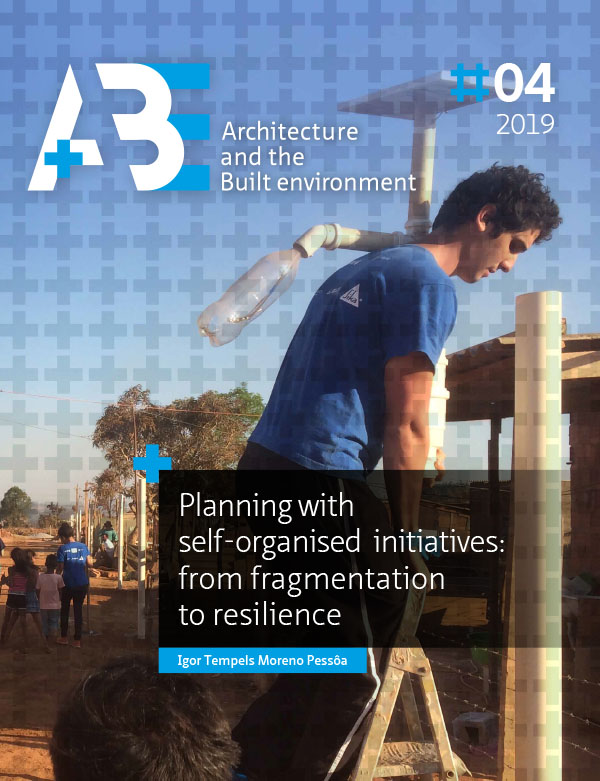Spatial fragmentation and self‑organisation
a negative relation in Brazilian metropolises
Keywords:
Spatial Fragmentation, self-organisation, self-organised initiatives, self-governanceAbstract
While Brazilian metropolises are spatially fragmented, at the same time they have abundant bottom-up, spontaneous, self-organised initiatives that usually emerge as a response to a weak or neglected public authorities. Both phenomena are influencing Brazilian metropolises, but we do not know how they influence each other. This paper aims to answer the question: To what extent does spatial fragmentation influence self-organised initiatives? The article is based on an analysis of data collected in São Paulo. It first develops a theoretical reflection on both concepts, fragmentation and self-organisation, followed by an outline of the methods and analysis. The results show that the spatial fragmentation pattern observed in São Paulo is defined by a strongly polarised urban structure that heavily influences the operation of self-organised initiatives. This imposes a limitation on the work area of self-organised initiatives. The study indicates that the relationship between spatial fragmentation and self-organised initiatives, however, is not straightforward and that spatial fragmentation hinders the expansion of the work self-organised initiatives.
References
Angel, S., Parent, J., & Civco, D. L. (2012). The fragmentation of urban landscapes: global evidence of a key attribute of the spatial structure of cities, 1990–2000. Environment and Urbanization, 24(1), 249-283. doi:10.1177/0956247811433536
Ashby, W. R. (1947). Principles of the Self-Organizing Dynamic System. The Journal of General Psychology, 37(2), 125-128. doi:10.1080/00221309.1947.9918144
Balbo, M., & Navez-Bouchanine, F. (1995). Urban Fragmentation as a Research Hypothesis: Rabat-Salé Case Study. Habitat International, 19(4), 571-582.
Caldeira, T. P. R. (2000). City of walls. Crime, segregation, and citizenship in São Paulo. Berkeley: University of California Press.
Cortes, J. M. G. (2008). Politicas Do Espaço: Senac Editora.
D’Ottaviano, M. C. L. (2008). Condomínios fechados na Região Metropolitana de São Paulo: fim do modelo centro rico versus periferia pobre? (Doctoral Thesis), University of São Paulo, São Paulo.
Dam, R. v., Eshuis, J., & Aarts, N. (2009). Transition starts with people: self-organising communities ADM and Golf Residence Dronten. In K. Poppe, C. Termeer, & M. Slingerland (Eds.), Transitions: Towards sustainable agriculture and food chains in peri-urban areas (pp. 81-92).
Dramstad, W. E., Olson, J. D., & Forman, R. T. T. (1996). Landscape ecology principles in landscape architecture and land-use planning. Washington, DC: American Society of Landscape Architects.
Eigen, M. (1971). Molecular self-organization and the early stages of evolution. Quarterly Reviews of Biophysics, 4(2&3), 149-212.
Foerster, H., & Zoepf, G. W. (1962). Principles of Self-Organisation. New York: Pergamon.
Haken, H. (1983). Synergetics : an introduction : nonequilibrium phase transitions and self-organization in physics, chemistry, and biology (3rd rev. and enl. ed.). Berlin ; New York: Springer.
Heylighen, F. (2008). Complexity and Self-organization. In M. J. Bates & M. N. Maack (Eds.), Encyclopedia of Library and Information Sciences. Boca Raton, FL: CRC Press.
IBGE. (2010). Aglomerados Subnormais: Informações Territoriais. Retrieved from http://www.ibge.gov.br/ home/presidencia/noticias/imprensa/ppts/00000015164811202013480105748802.pdf
IBGE. (2015a). População presente e residente. Retrieved from http://seriesestatisticas.ibge.gov.br/series. aspx?no=10&op=0&vcodigo=CD90&t=populacao-presente-residente
IBGE. (2015b). Taxa de Urbanização. Retrieved from http://seriesestatisticas.ibge.gov.br/series.aspx?no=10&op=0&vcodigo=POP122&t=taxa-urbanizacao
Kee, T., & Miazzo, F. (2014). We own the city : enabling community practice in architecture and urban planning. Amsterdam: TrancityxValiz.
Kotus, J., & Hławka, B. (2010). Urban neighbourhood communities organised on-line – A new form of self-organisation in the Polish city? Cities, 27(4), 204-214. doi:http://dx.doi.org/10.1016/j.cities.2009.12.010
Kovacic, Z., & Giampietro, M. (2016). Between theory and quantification: An integrated analysis of metabolic patterns of informal urban settlements. Energy Policy. doi:http://dx.doi.org/10.1016/j.enpol.2016.06.047
Lister, N.-M., Brocki, M., & Ament, R. (2015). Integrated adaptive design for wildlife movement under climate change. Frontiers in Ecology and the Environment, 13(9), 493-502. doi:doi:10.1890/150080
Lydon, M., & Garcia, A. (2015). Tactical Urbanism. Washington, DC: Island Press.
Maricato, E. (2011). O Impasse da Política Urbana no Brasil. Petrópolis, RJ - Brazil: Vozes.
Newman, L., Waldron, L., Dale, A., & Carriere, K. (2008). Sustainable urban community development from the grassroots: Challenges and opportunities in a pedestrian street initiative. Local Environment, 13(2), 129- 139. doi:10.1080/13549830701581879
Nunbogu, A. M., Korah, P. I., Cobbinah, P. B., & Poku-Boansi, M. (2017). Doing it ‘ourselves’: Civic initiative and self-governance in spatial planning. Cities. doi:https://doi.org/10.1016/j.cities.2017.10.022
Pessoa, I. M., Taşan-Kok, T., & Altes, W. K. (2016). Brazilian urban porosity: treat or threat? Proceedings of the Institution of Civil Engineers - Urban Design and Planning, 169(2), 47-55. doi:doi:10.1680/udap.15.00009
Portugali, J. (1999). Self-organization and the city. New York: Springer.
Rauws, W. (2016). Civic initiatives in urban development: self-governance versus self-organisation in planning practice. Town Planning Review, 87(3), 339-361. doi:10.3828/tpr.2016.23
Ribeiro, L. C. d. Q., & Ribeiro, M. G. (Eds.). (2013). Ibeu: índice de bem-estar urbano (1 ed.). Rio de Janeiro: Letra Capital.
Sabatini, F., & Salcedo, R. (2007). Gated communities and the poor in Santiago, Chile: Functional and symbolic integration in a context of aggressive capitalist colonization of lower–class areas. Housing Policy Debate, 18(3), 577-606. doi:10.1080/10511482.2007.9521612
Santos, M. (1990). Metrópole Corporativa Fragmentada: o caso de São Paulo. São Paulo: Nobel.
Santos, M. (2009). Metrópole Corporativa Fragmentada. São Paulo: Universidade de São Paulo.
Santos, M., & Dias, J. F. (1982). A urbanização desigual: a especificidade do fenômeno urbano em países subdesenvolvidos: Editora Vozes.
Schmidt-Thome, K., Wallin, S., Laatikainen, T., Kangasoja, J., & Kyttä, M. (2014). Exploring the use of PPGIS in self-organizing urban development: Case softGIS in Pacific Beach (Vol. 10).
Swyngedouw, E., & Moulaert, F. (2010). Can neighbourhoods save the city? : community development and social innovation / edited by Frank Moulaert ... [et al.]. In F. Moulaert (Ed.), Regions and cities. (pp. 219–234). New York: Routledge.
Tonkens, E. (2008). De bal bij de burger. Burgerschap en publieke moraal in een pluriforme, dynamische samenleving. Amsterdam: Vossiuspers UvA.
Vilaça, F. (2011). São Paulo: Segregação urbana e desigualdade. Estudos Avançados, 25(71), 37-58.
Wunsch, J. S. (2013). Analyzing self-organized local governance initiatives: Are there insights for decentralization reforms? Public Administration and Development, 33(3), 221-235.

